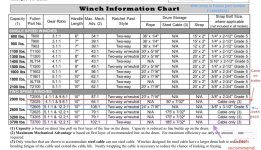So I can stop hijacking my own thread on side guides, I'll start a new one with my winch question. I have read over quite a few threads in the archives, and with the knowledge gained have chosen a winch that looks good (Fulton T2605). This winch can be bought set up for either strap or cable (but you have to choose one or the other at time of purchase).
I have nothing against wire rope (cable) in general, but on the face of it, a strap seems more appealing in this case. No corrosion and no chance of overwraps. (I would probably make a little cover to keep the UV off the strap, or else plan on replacing it more often.) My current winch has an aged, in need-of-replacement cable and relatively little pulling power, btw (see chart). It's also kind of rusty and tired overall (my boat was kept in a building all its life, but the trailer was outdoors).
So, is there any reason (besides UV) that I *wouldn't* want a winch with a strap instead of a cable?
Here's a chart showing my original winch (T2025), the oft-recommended T3700, and the T2605, which is my current favorite.

One other question: The chart shows that my current winch, and the T2605 both have neutral, but the oft-recommended T3700 doesn't. How does this affect actual launching/retrieving?
Sunbeam
I have nothing against wire rope (cable) in general, but on the face of it, a strap seems more appealing in this case. No corrosion and no chance of overwraps. (I would probably make a little cover to keep the UV off the strap, or else plan on replacing it more often.) My current winch has an aged, in need-of-replacement cable and relatively little pulling power, btw (see chart). It's also kind of rusty and tired overall (my boat was kept in a building all its life, but the trailer was outdoors).
So, is there any reason (besides UV) that I *wouldn't* want a winch with a strap instead of a cable?
Here's a chart showing my original winch (T2025), the oft-recommended T3700, and the T2605, which is my current favorite.

One other question: The chart shows that my current winch, and the T2605 both have neutral, but the oft-recommended T3700 doesn't. How does this affect actual launching/retrieving?
Sunbeam
